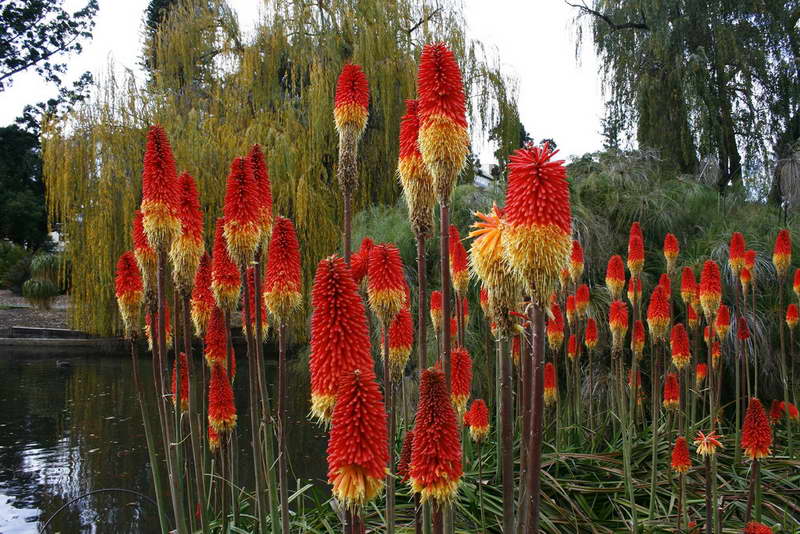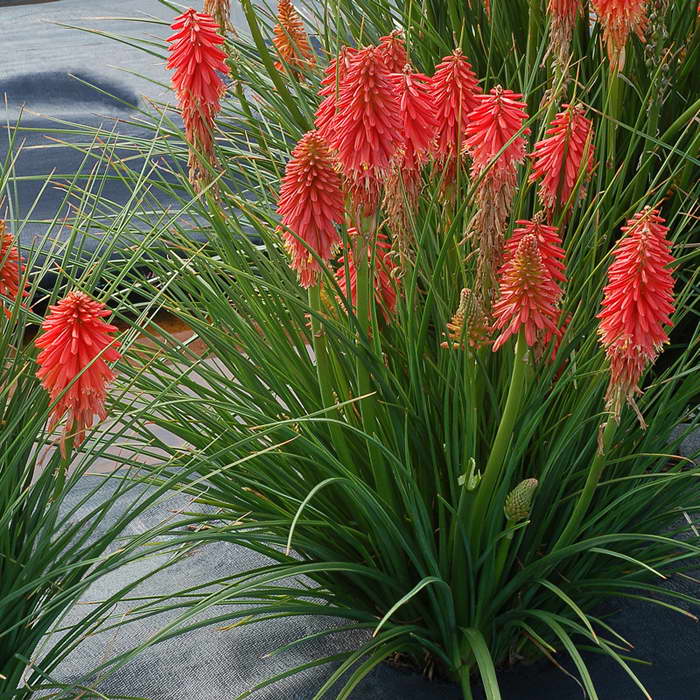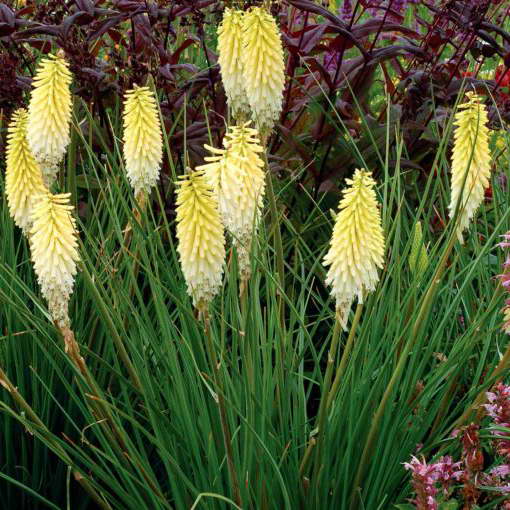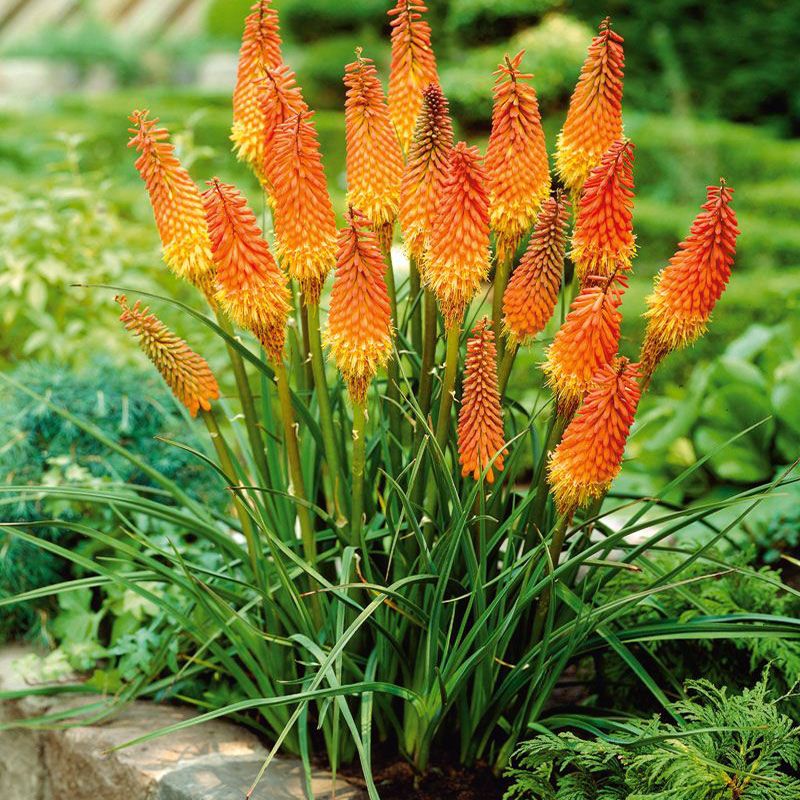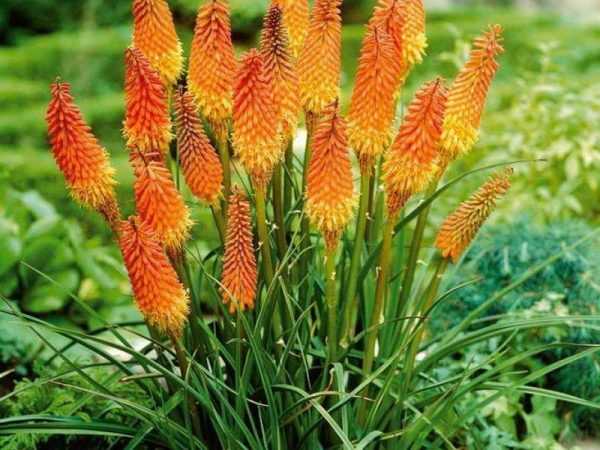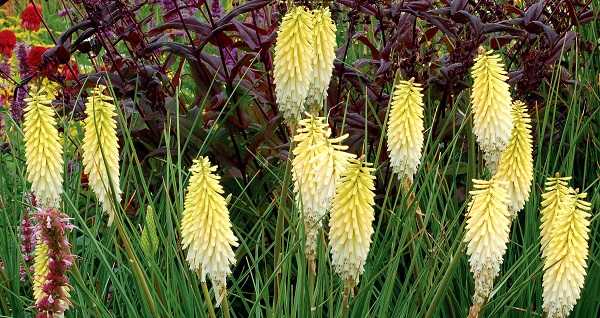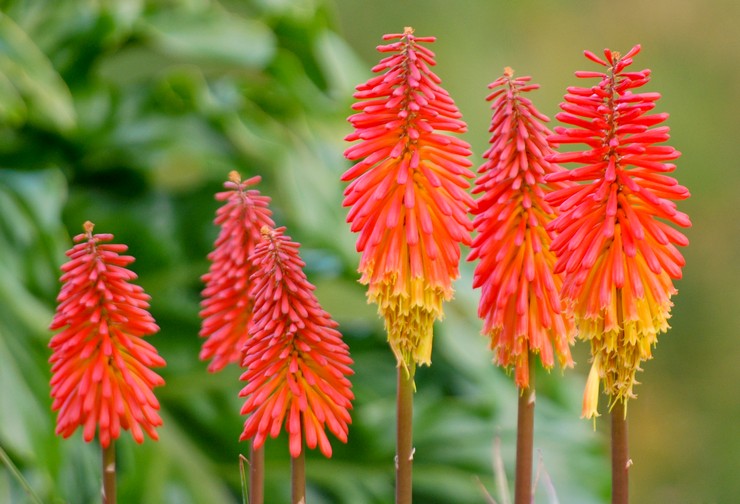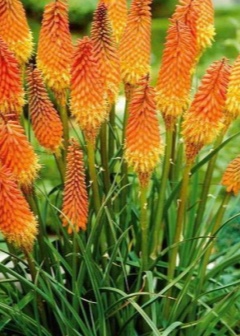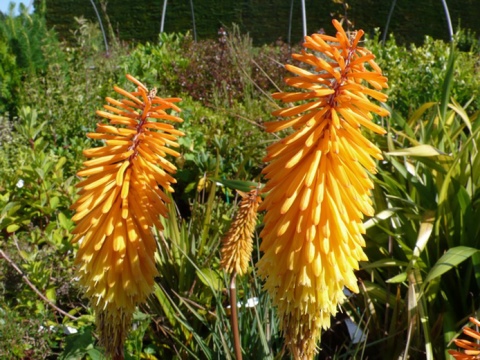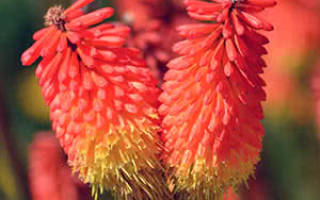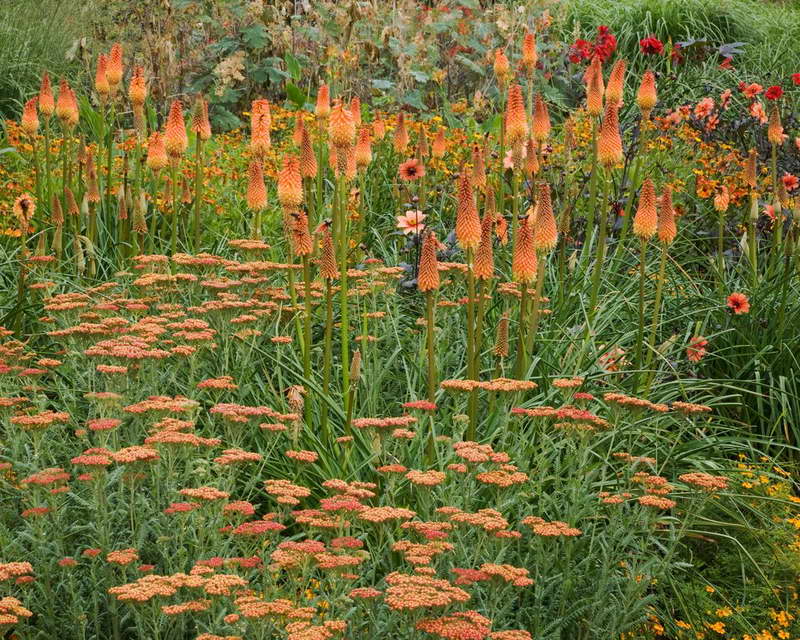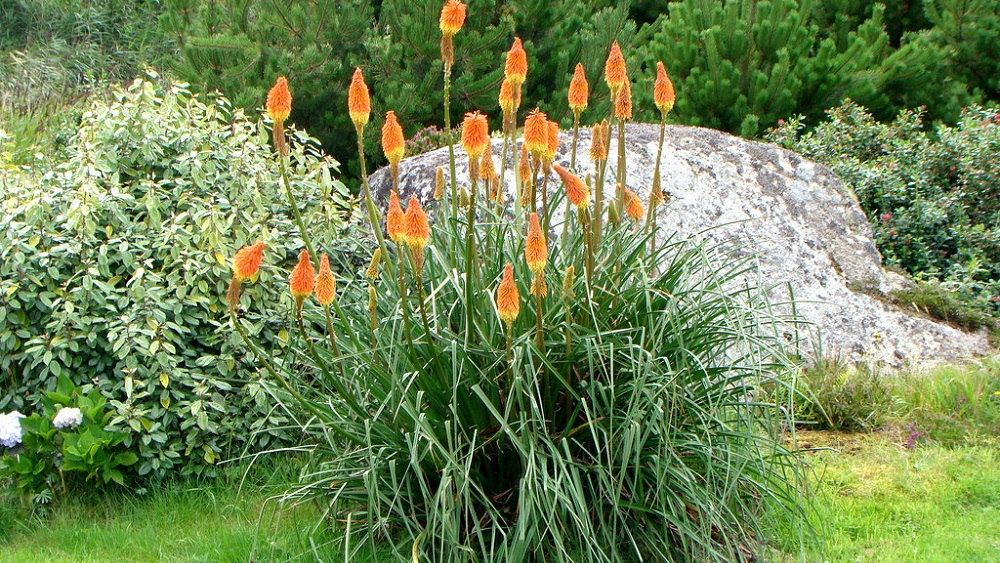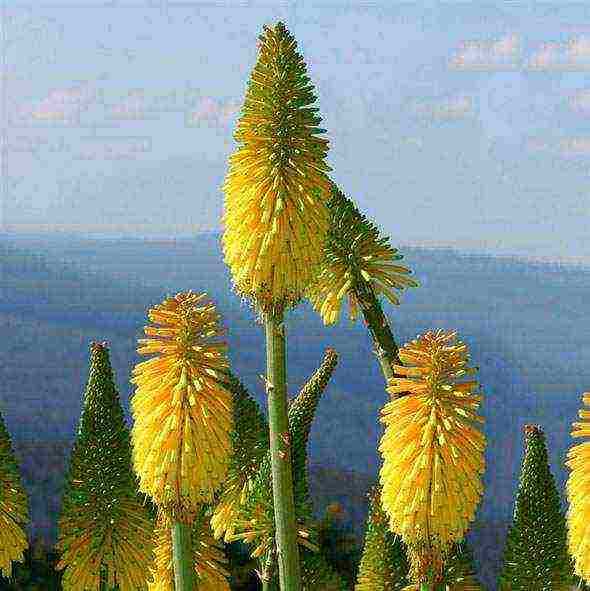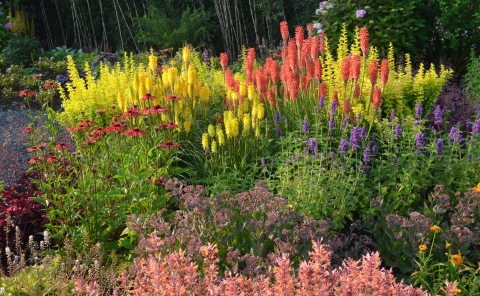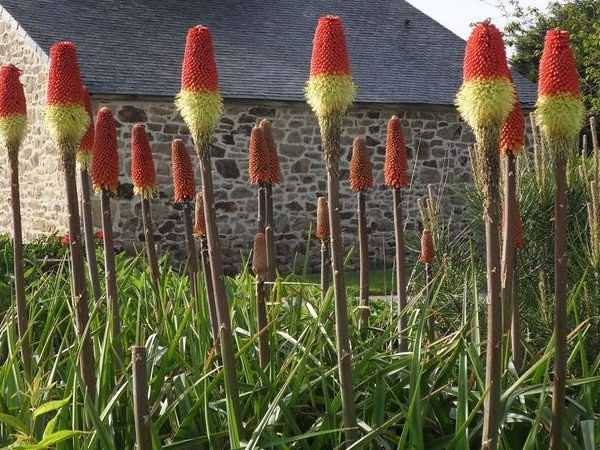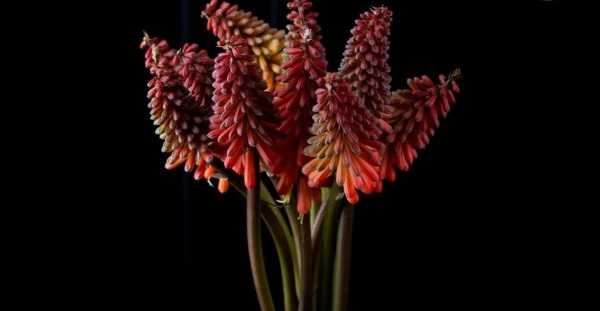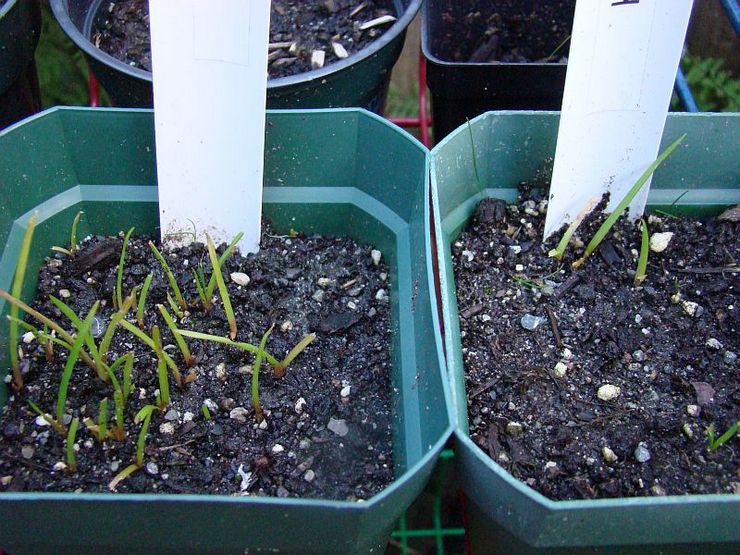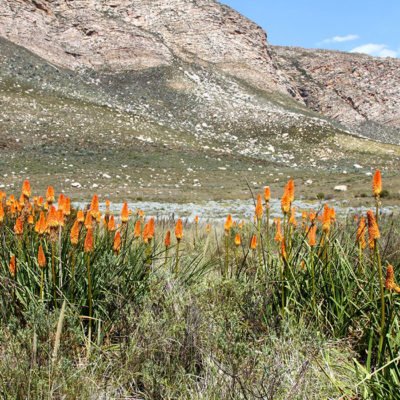Planting and caring for the plant
Since the birthplace of the knifofia flower is such hot countries as Africa and the no less sunny Madagascar, this must be taken into account when planting a perennial. 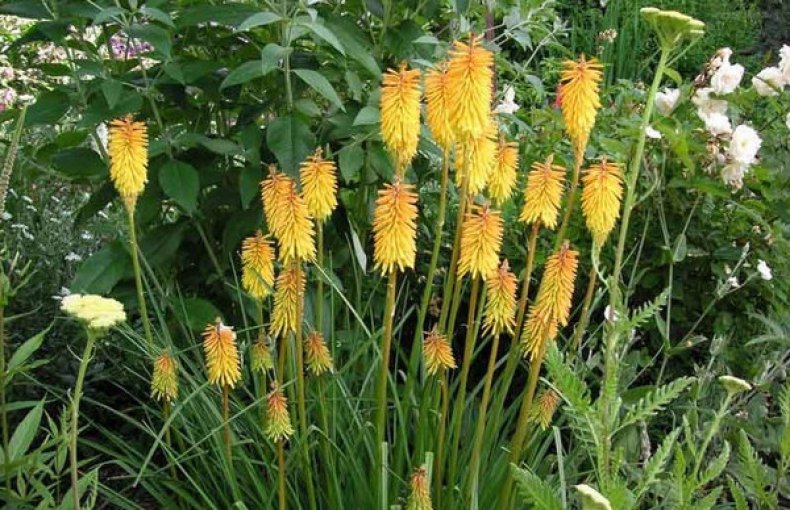
Seat selection
For the African beauty, sun and light throughout the day are essential for normal development. In shaded areas, the cniphophy loses its rich color, its growth slows down. Doesn't like drafts. It grows poorly in lowlands and does not tolerate stagnant moisture.
Sandy soils that are well fertilized and loosened are suitable for this culture. The size of the hole depends on the plant itself - how big it is. A drainage layer is necessarily laid out at the bottom of the hole, then fertile soil is introduced.
Knifofia is a drought-resistant perennial that does not require frequent watering. Knifofia is very susceptible to excess moisture, so it is better to plant it in elevated places or areas with a good drainage system.

In the spring, as soon as the first green leaves appear, they feed the perennial with nitrogen fertilizers. After a while, organic fertilizers can be applied in the form of humus, compost, peat.
After the end of flowering, the knifofia are fed with fertilizers, which include potassium or ash, - this way it will receive additional nutrition and winter better.
Choosing a place for knifofia, its planting and subsequent care in the open soil, certain rules must be followed. Proper watering, timely application of fertilizing and fertilization, plant pruning are three components that affect the development of the culture, its flowering.
Pruning is done in the spring, immediately after the shelter is removed (if the plant has wintered in the open field). The frost-bitten, yellowed parts of the bush are removed. After the perennial has faded, its peduncles are removed at the root. It makes no sense to collect seeds from plants growing in our latitudes, since they are hybrids and do not inherit maternal traits.

In each climatic zone, the wintering of knifofia is carried out in different ways. In the southern regions, the perennial hibernates in the open field, but it must be covered for the winter. In the autumn, perennial leaves are tied to prevent moisture from entering the plant sockets, sprinkled with foliage or covered with spruce branches, insulation with a film is possible. When using the film, ventilation holes must be provided; you can just press the film loosely to the ground, leave gaps. With such a shelter, the plant tolerates frosts with readings up to -15 ° C.
In the northern regions, knifofia is not left for wintering in the open ground: it must be dug up, placed in a container with nutritious soil and a good drainage layer. A perennial hibernates in rooms with a temperature not exceeding + 8 ° C.
Features of levisia
The low-growing perennial plant Levisia is a succulent, and it belongs to the Montiev family. Under natural conditions, this adorable flower, whose height is no more than 0.3 meters, can be found only in North America. Most often, levisia is found on gravelly soils and rocky slopes at an altitude of more than 800 meters above sea level.
Small nodules form on the powerful root system. The bush firmly clings to the soil with its roots, trying to grow into it as deeply as possible. This evergreen plant is distinguished by its thermophilicity and demanding growing conditions.
Particular attention should be paid to soil moisture levels. If the soil is excessively dry, it can lead to massive foliage flying.
But the stagnation of liquid in the ground can cause the death of this succulent.
In autumn and spring, Levisia bushes adorn spectacular green leaf plates. In April or May, numerous flowers of a rich color appear on them. Such a perennial fades in the last days of September.
Levisia has a rounded leaf rosette, the diameter of which can vary from 0.3 to 0.4 m. The shape of the leaf plates is lanceolate or oval-elongated. They are fleshy, leathery to the touch and firm. The surface of the leaves is smooth and dark green.
During flowering, an erect peduncle rises above the leaf rosette, the length of which can vary from 15 to 20 centimeters. Several large flowers open at the top of the peduncle. In comparison with a bush, the flowers of Levisia are incredibly large. In diameter, each of them can reach up to 50 mm. Narrow (up to 0.5 cm wide) with a torn edge, the petals are pointed at the top, and in length they reach about 20 mm. Flowers can be painted in different shades: pink, lilac, red or yellow shade is effectively combined with white. The core of the flowers is colored yellow, it has a central pistil and several stamens on long legs. When the flowers wilt, a rounded fruit forms, reaching about 0.4 cm in diameter.
Plant care
 Growing by seeds and vegetatively, caring for plants is not particularly difficult. It is only necessary to regularly water, weed and mulch the soil. Watering should be moderate, as excessive moisture negatively affects the plant. However, on sunny days, it is made more abundant.
Growing by seeds and vegetatively, caring for plants is not particularly difficult. It is only necessary to regularly water, weed and mulch the soil. Watering should be moderate, as excessive moisture negatively affects the plant. However, on sunny days, it is made more abundant.
For the winter period, the knifofia is prepared in a special way in order to protect it from freezing. After flowering, the peduncles are cut off from the plants, the leaves are tied in bunches and everything is covered with sawdust, fallen leaves or spruce branches of coniferous trees. The top is additionally covered with roofing material, leaving small ventilation holes to avoid overmaturity.
If the winter is with little snow or too wet, then the plants may die from freezing. To be on the safe side, knifofia bushes are transplanted into special containers in which the soil must be periodically moistened. The containers are kept in a dry basement at a temperature of 1-8 degrees. Planting of plants for cultivation in the open field is carried out only in late May - early June.
If the bushes remain hidden in the ground, then they should be gradually opened to acclimatize to sunlight. It is not recommended to prune the leaves for the winter period, since knifophya is an evergreen plant. Otherwise, it can negatively affect flowering. In the spring, before the start of the season, plant care begins, they are examined, dry leaves are removed and healthy ones are cut.
Top dressing and fertilization of knifophytes
Fertilizing is done twice in the entire season. After the appearance of young leaves, fertilizing is carried out with mineral fertilizers containing nitrogen and organic substances. Diluted chicken manure can be used. Compost, humus, peat are used as organic fertilizers. In the second half of summer, after flowering, potash fertilizers or ash are applied, which helps the plants to endure the winter. Dark stones can be placed near the cniphophies, which emit additional heat necessary for growing flowers.
Pests and diseases
If the plant receives proper care, regular watering, and feeding with the necessary fertilizers, then it is not susceptible to diseases and feels good. Excessive watering can cause root rot.
In this case, the method of treating cniphophia is fungicide treatment.If the plant no longer responds to treatment, then it must be urgently removed, as there is a risk of contamination of other flowers.
Among the insects that can harm the plant are aphids, spider mites, thrips. They are destroyed by spraying with an insecticide.
Knifofiya planting and care in the open field
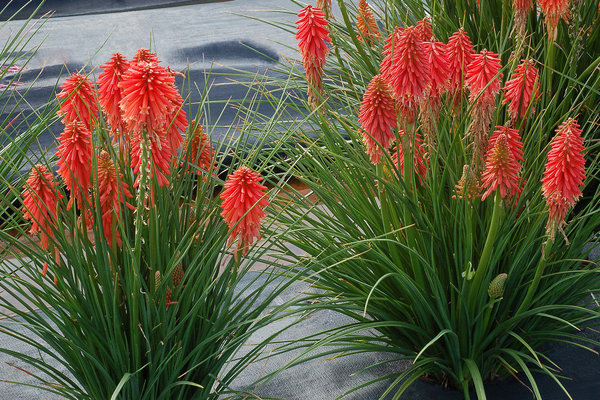
Knifofiya planting and care in the open field
It is permissible to transplant the plant into the ground after the frosts have passed and there will be stable warm weather. Adult flowers can even survive temperatures slightly above 0, but seedlings need temperatures around 10-12 degrees.
Knifofia does not like shaded areas, this plant is very light-requiring. It is preferable to plant knifofia on the south side of the garden, preferably on a hill. If you plant it in the shade, its leaves will lose their brightness and growth will slow down. The plant prefers a moisture-absorbing soil that allows air to pass through well. Knifofia does not react well to an excess of moisture, this can harm her. Sandy soil is most suitable for her.
Many gardeners are faced with the fact that the knifofia does not want to bloom. The reason for this may be the wrong landing site, for example, if it was planted in the shade, as well as the close location of groundwater. In this case, it is better to transplant the flower, otherwise it may die.
The soil is prepared before planting the plants, the site is dug up, sand is added and well leveled with a rake, if necessary, fertilizers are applied. In the prepared area, planting holes are made, keeping a distance of 30-40 cm between them. Each hole is watered with water, and then a plant is planted there. The size of the pits should correspond to the size of the rhizomes of the plants along with a lump of earth. Placing plants in the holes, they are covered with earth and lightly tamped, then watered again.
Caring for knifofia and growing it in your flower bed is not such a difficult task. Despite the exoticism of the flower, anyone can grow it. In the first year, after transplanting the knifofia into the ground, you must not forget to water it, loosen the soil, and weed. In the first year of life, the cniphophia will not bloom, it will be possible to admire the flowering only the next season, when the root system of the plants is sufficiently strong. To enjoy the bloom of knifofia, you need to adhere to all the simple rules of caring for it.
Cultivation and reproduction of knifofia
New plants are obtained by vegetative and reproductive methods. When choosing the latter, seeds are used. Planting material must be purchased in specialized stores. The need for this is due to the insufficient number of warm daylight hours. The process of growing seedlings from seeds is laborious.
Sowing is carried out in the second half of March. To increase germination, the box is covered with glass or film for 2-3 weeks. The greenhouse should be removed for ventilation, and the soil should be regularly moistened.

After emergence, seedlings begin to harden at room temperature. The need for a pick arises when two leaves are formed on the stem. Landing in open ground is carried out in the middle of summer. The perennial blooms only in the third season.
The vegetative method of reproduction is to separate the daughter outlets. Three-year-old bushes are suitable for this. The resulting sections are treated with charcoal. The resulting sockets are planted in holes. Saplings need temporary shading. In this case, kniphofia blooms one year after planting.
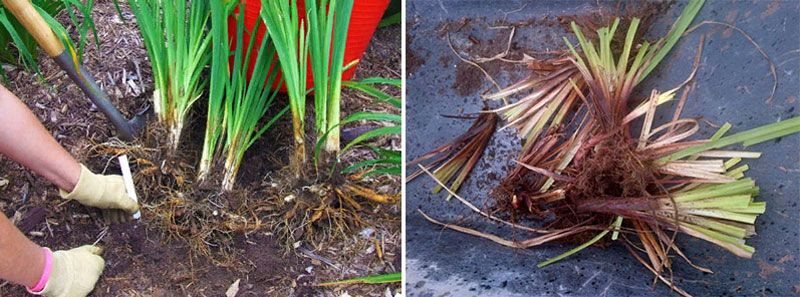
Description of species
A small number of species are cultivated in Russia and in Europe.
Kniphofia tuckii
This type of knifophy comes from South Africa. It was discovered by a scientist in 1892, after whom the variety was named. It is represented by a shrub up to 80 cm in height. The leaf plates are xiphoid and up to 40 cm long. The inflorescences grow about 15 cm in length and consist of small red and yellow flowers.

What does Taka's knifophia look like?
Knifofia Tukka, as it is also called, is widely popular among mid-latitude flower growers. With proper preparation for winter and organization of shelter for the winter, the plant can tolerate severe frosts.
Berry Kniphofia (Kniphofia uvaria)
In nature, the berry tritoma knifofia grows only in the Cape province. It is represented by a vigorous shrub up to 2 m high. Elongated xiphoid leaves grow about 50 cm in length. The inflorescences are large, about 25 cm. Below they contain flowers of yellow-green color, and towards the top they turn into red-coral tones.
Important! The flowering period of this variety is 2 months. Berry knifofia has several varieties:
Berry knifofia has several varieties:
- Dr. Kerr. A distinctive feature are peduncles up to 1 m long and inflorescences up to 25 cm. Blossoms mainly in lemon-yellow shades;
- Fire Flame. The average height of the bush. Flowers of a red hue;
- Eskimo. Meter bush. In the lower part of the peduncle, yellow flowers bloom, and the upper ones can be of various shades: red, scarlet, orange, coral;
- large-flowered. The bush grows up to 1.4 m in height. Inflorescences are fiery red;
- Orange Beauty. Peduncle more than 1 m high. Flowers are rich orange shades.
Hybrid Knifofia (Kniphofia x hybrida)
Hybrid cniphophy means several varieties that were created on the basis of the berry shape.

One of the varieties of hybrid knifophy
It:
- Cardinal. Inflorescences are represented by fiery red flowers. The shrub grows up to 1.2 m in height;
- Golden Skeeper. It is characterized by large inflorescences and bright yellow flowers. Plant height is average;
- Abenzonne. Shrub of medium height. On the inflorescences, yellow flowers bloom from below, and to the top they turn into red shades;
- Indiana. Plant no more than 1 m in height. Flowers in red-orange colors;
- Prince Maurito. Medium-sized shrub with reddish-brown flowers.
Caring for knifophy
During the growing season, the plant needs abundant watering, especially in the summer. It is better to water in the morning, periodically loosen the ground around the bushes and remove weeds. You can mulch the area with needles. They are fed twice: in early spring, as soon as foliage appears, and before flowering. You can use humus, peat, mineral fertilizers. Inflorescences that have begun to dry out are best removed. However, foliage is not cut off even before the onset of cold weather. Otherwise, in the spring, the plant will spend energy on the development of green mass and bloom sparsely. Fasten the leaves, and in April remove only the spoiled ones.

Knifofia tolerates frost well and is suitable for growing in the middle lane, but for the winter it needs shelter. It is enough to sprinkle with dry foliage, then cover with spruce branches and on top with a film, but not too tightly, and leave a gap at the surface for ventilation so that the bushes do not get stuck. In March, the shelter can be gradually disassembled, allowing the plant to adapt to the sun and coolness.
If the frost is too severe, the temperature drops well below -15 ° C, then the superficial root system may suffer. Then the plants are dug up, transplanted into containers and stored in the basement, regularly watered and kept at a maximum temperature of 8 ° C.
Do not be afraid of the whims of the beauty. If you provide the plant with proper care, it will develop well and practically not get sick. Unless thrips and other insect pests can sometimes attack, which insecticides will help to cope with.
In landscape design, perennials are often planted in groups in mixborders, near water bodies, for decorating fences and fences. You can effectively place exotic "torches" and one by one. Hybrids and varieties differ in shades and sizes, and their combination will create a delightful composition. For example, for alpine slides and rockeries, the undersized Little Maid knifofia is suitable, it barely reaches 50 centimeters in height.Thomson's slender three-meter knifofia will help to design an artificial fence.
It is worth paying attention to the flowering period. Early varieties bloom in early summer (Modest, Springtime, Alcazar, Royal Standard), later in the middle of autumn (Nelson, Galpini, John Benary)
The plant is also suitable for cutting, a gorgeous bouquet will decorate the room for at least two weeks.
Description of bnifophy
According to the botanical description, kniphofia is a very beautiful perennial herbaceous rhizome plant with a height of 1-2.5 m. Thomson's knifofia can reach 3 m in height. The rhizome is short and thick. The leaves are leathery, dense, tough, collected in a basal rosette, have a bright green color and a xiphoid shape. The length of the leaves varies from 50 to 90 cm, depending on the species and variety.
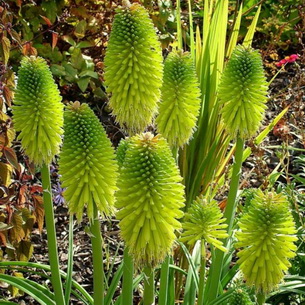
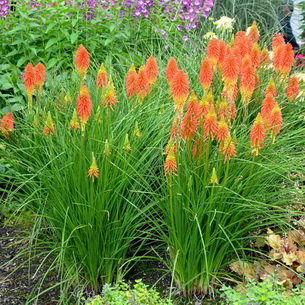
From the central part of the rosette, a non-leafy, unbranched peduncle grows, at the top of which a sultan-shaped, racemose or spike-shaped inflorescence is formed. The inflorescence consists of many small, drooping brightly colored flowers, which open gradually, starting from the top.
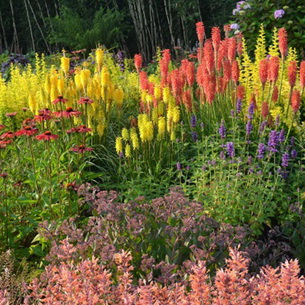
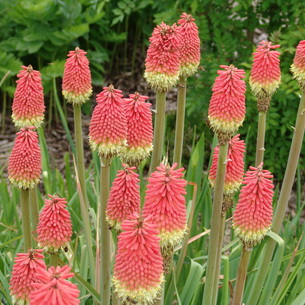
In the photo of the knifofia presented above, you can see that the color range of flowers is diverse. The buds are most often colored red, orange, yellow. On one peduncle can be flowers of different shades. It is noteworthy that during the flowering period, the buds are able to change color.
Knifofia blooms from early July to late September.
Follow-up care
It will not be difficult even for an inexperienced gardener to grow knifophy in the Moscow region or in another region of Russia. The first phase of flowering of the shrub falls on the next season after planting, provided that the root system is strengthened. In order for the plant to please with its decorative effect, it is worthwhile to moderately moisten the soil, weed, mulch, loosen it, and also fertilize the culture.
Watering
Irrigation of tritomas can be carried out by spraying or watering at the root. It is strictly forbidden to perform this procedure in the heat of the day, otherwise the plant will burn the foliage and lose its decorative effect. In summer, it is necessary to irrigate the shrub every 3-4 days. In winter, when in the basement, the knifofia is watered every 30 days. The main rule in this event is to maintain low soil moisture.
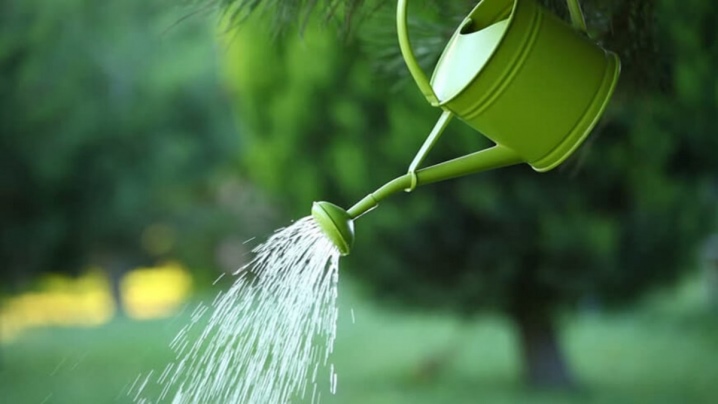
Fertilizer
At the beginning of the growing season, the plant needs nitrogen-containing fertilizing. For this purpose, you can use a complex mixture, for example, azophoska, nitroammophoska, urea, saltpeter, double or ordinary superphosphate. It is not worth using nitrogen for a long time, since the active development of green mass with delayed flowering or its absence is possible.
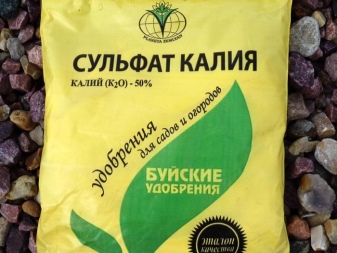

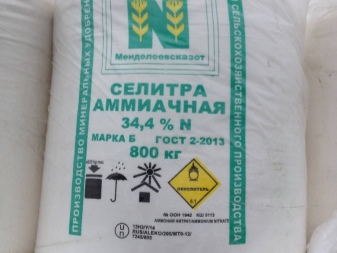

The culture needs phosphorus during the growing season. Fertilizer is applied to autumn flower beds, as well as in the spring before the planting process. For this purpose, it is possible to use phosphate rock, which is considered a long-acting fertilizer. This top dressing must be applied to the ground every 3-4 years.
Of organic fertilizers, humus is considered the most suitable for knifophy. Fresh manure can be hazardous due to the release of methane that burns the root system. Many gardeners infuse wood ash or mix the substrate with compost.
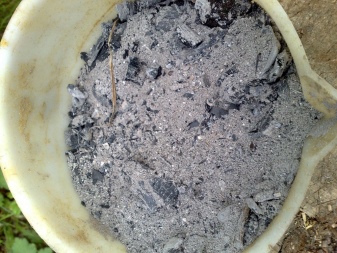

Pruning
It is necessary to cut off the yellowed foliage of an ornamental shrub in the spring, after removing the film cover. If the knifofia spent the winter in the basement, then she does not need this procedure. At the end of the flowering phase, it is required to eliminate the peduncles up to the root. Otherwise, old flower stalks will take nutrients from the roots.
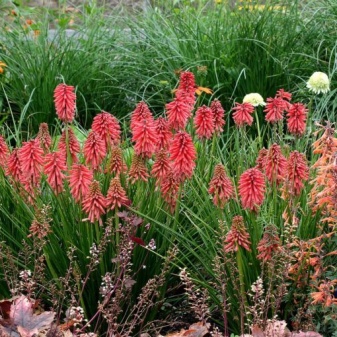
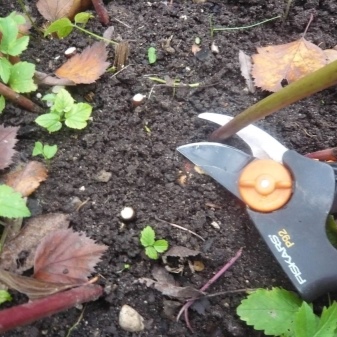
Preparing for winter
A tritoma growing in middle latitude is not long-lived. But within a few years, she will be able to decorate the site with her presence. Before the onset of winter, the bush should be cut off the arrows without affecting the leaves.Preparing the flower for the cold, tritoma foliage should be carefully tied. The next steps will be to cover the shrub with peat chips and cover with spruce branches.
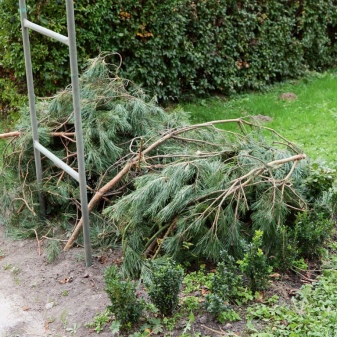
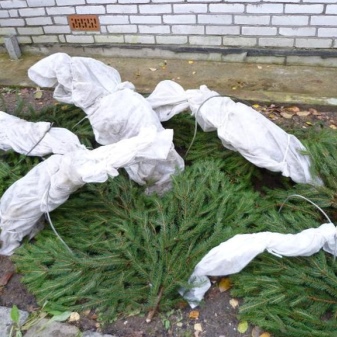
Transplant in the fall
Digging up a culture and bringing it into the room can extend its life. To do this, it is worth removing the flower from the soil, then planting it in a large container. The room in which the knifofia will be stored must be cool. The gardener should make sure that the root system of the shrub does not dry out, so from time to time the culture should be watered with a small amount of liquid. Planting tritomas in open soil can be done in late spring or early summer.
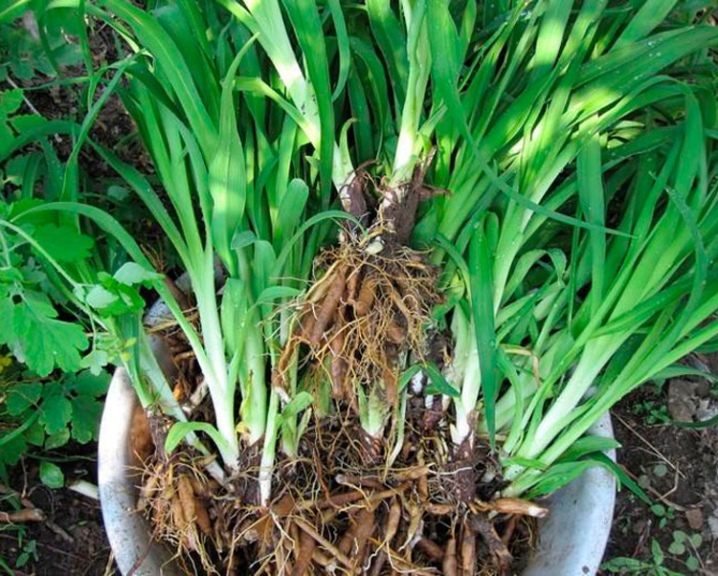
How to grow knifofia
Growing and caring for knifofia will not cause much trouble if you immediately choose the right place. The area where water stagnates is categorically not suitable - the plant will bloom poorly, and the roots may die. But on a heated slide with fertile and drained land, the southern beauty will take root remarkably. You can prepare a special soil: mix turf and leafy soil, humus and sand in equal parts. Stones are often laid around the bushes of undersized species. When heated, they will transfer heat to the ground.
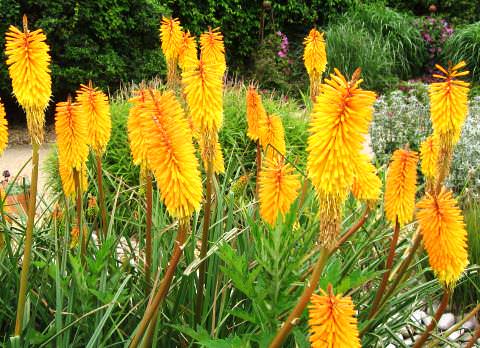
Knifophya is propagated by seeds, however, in the middle lane they do not always have time to ripen. Most often they use the vegetative method, planting daughter plants.
A mixture of several types of seeds is often sold in stores. It is worth sowing them closer to the end of March in containers with nutrient soil. Then the plantings are covered with foil and left for 14-21 days. Such a "greenhouse" will have to be ventilated and humidified from time to time, you can spray it. Seedlings usually appear amicably, gradually they will get used to room temperature and acquire 2-3 leaves. In July, matured plants are transplanted to a permanent place, leaving about 40 centimeters of distance between the rows and holes. Young specimens will bloom in the second or third year of life.
In 3-year-old cniphophia, daughter processes begin to appear from the buds in the axils of the lower leaves.
Then the bushes can be dug up in April or early May, carefully separate the daughter socket with roots and plant it in the soil. Young seedlings need regular watering and light partial shade, in a year they will bloom
About once every 5 years, it is advisable to dig up a perennial and divide the rhizome.
How are knifophias used in the garden
An unusual bright and very beautiful flower with long flowering and lush green foliage allows you to create a variety of original compositions in the garden that will revitalize and transform any area.
Knifofia can be planted with other perennials, taking into account their flowering time, as well as the peculiarities of caring for them. Excellent neighbors of the African guest are decorative grasses, some green manure plants, for example, lupine, sage, gypsophila, dahlias, irises and many other tall flowers.


Knifofia retains its decorative effect throughout the season due to long flowering and lush foliage, which beautifully complements large variegated inflorescences.
You can also plant it singly on lawns, garden paths and other places in the garden where you need to fill the space.
Low-growing species and varieties are used to decorate alpine slides and rockeries.
Wherever this amazingly beautiful exotic is planted in the garden, it will always attract attention and become an exquisite decoration of the site.

